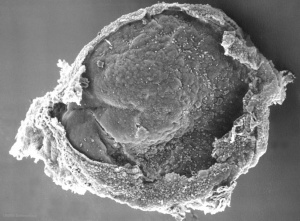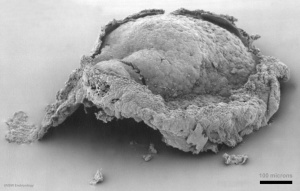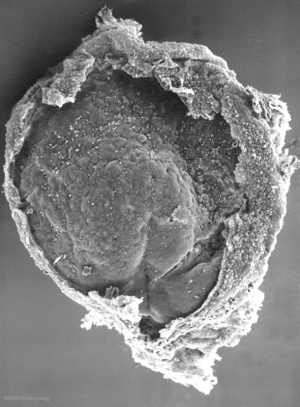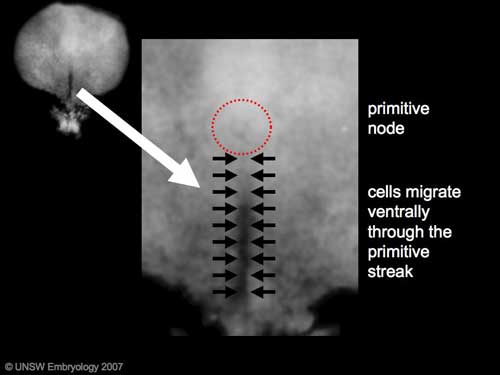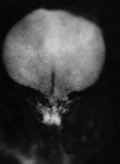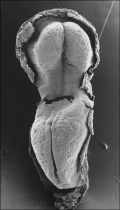2011 Lab 2 - Week 3
| 2011 Lab 2: Introduction | Week 1 | Week 2 | Week 3 | Online Assessment | Group Project |
Introduction
- Week 3 Links: Lecture - Week 3 | Gastrulation | Placenta | Coelomic Cavity
- Embryo Week: Week 1 | Week 2 | Week 3 | Week 4 | Week 5 | Week 6 | Week 7 | Week 8 | Week 9
Conceptus Cavities Week 2 and Week 3
| File:Chorion 001 icon.jpg</wikiflv> | Animation shows the events following implantation and focuses on changes in the the spaces surrounding the embryonic disc, the extraembryonic coelom. The blastoceol cavity is converted into two separate spaces: the yolk sac and the chorionic cavity. The third space lies above the epiblast, the amniotic cavity.
blue - epiblast layer yellow - hypoblast layer red cells - extraembryonic mesoderm layer green - trophoblast layer red spaces - blood-filled spaces, maternal lacunae white cells - (left) endometrial gland (right) endometrial epithelium |
Germ Layers and Dynamic Processes
- From 1 layer of cells to 3 layers that define all tissues of the entire embryo.
The conceptus is now fully implanted in the uterine wall. This time is now when a small cluster of cells (the inner cell mass) will differentiate into two simple cell layers (epiblast and hypoblast). From the single epiblast layer cells will migrate through a narrow region (primitive streak) to form firstly two layers epiblast and endoderm, then later the three layers ectoderm, mesoderm and endoderm. These final three layers (germ layers) are the trilaminar embryo and will form all the tissues of the body.
During implantation cells on the outside (trophoblast layer) of the conceptus are forming part of the early placenta. The cells on the inside (inner cell mass) now begin to form the three germ layers that will form the entire embryo. Note that as the conceptus also forms the fetal component of the placenta, not all cells from our blastocyst will form part of the developing embryo.
The images below show the embryo (week 3 between 15 to 17 days) as a disc 0.4 mm diameter in size.
Stage 7 Human Embryo (15 to 17 days)
Stage 10 Human Embryo (22 to 23 days)
Stage 7
Gastrulation
Carnegie Stage 7 and 8, gastrulation, migration of cells through the primitive streak to form endoderm and mesodermal layers of embryo.
 Scanning electron micrograph showing the early forming 3 layers: ectoderm, mesoderm and endoderm.
Scanning electron micrograph showing the early forming 3 layers: ectoderm, mesoderm and endoderm.
Timeline - Week 3
| Event | ||
| Stage 7 | Gastrulation primitive node (Hensen's node, primitive knot) The small circular region located at the cranial end of the primitive streak, where gastrulation occurs, and is a controller of this process. The second role is to act as an initial generator of the left-right (L-R) body axis. | |
| Stage 8 | Neural - neurogenesis, neural groove and folds are first seen | |
| Stage 9 |  Musculoskeletal - somitogenesis, first somites form and continue to be added in sequence caudally Musculoskeletal - somitogenesis, first somites form and continue to be added in sequence caudally
Neural - the three main divisions of the brain, which are not cerebral vesicles, can be distinguished while the neural groove is still completely open Neural Crest - mesencephalic neural crest is visible[1] | |
| Heart - cardiogenesis, week 3 begins as paired heart tubes. |
- Carnegie Stages: 1 | 2 | 3 | 4 | 5 | 6 | 7 | 8 | 9 | 10 | 11 | 12 | 13 | 14 | 15 | 16 | 17 | 18 | 19 | 20 | 21 | 22 | 23 | About Stages | Timeline
Week 2 and 3 Movies
| Implantation | Mesoderm | Chorionic Cavity | Amniotic Cavity | Week 3 |
References
- ↑ <pubmed>17848161</pubmed>
| 2011 Lab 2: Introduction | Week 1 | Week 2 | Week 3 | Online Assessment | Group Project |
Glossary Links
- Glossary: A | B | C | D | E | F | G | H | I | J | K | L | M | N | O | P | Q | R | S | T | U | V | W | X | Y | Z | Numbers | Symbols | Term Link
Cite this page: Hill, M.A. (2024, April 28) Embryology 2011 Lab 2 - Week 3. Retrieved from https://embryology.med.unsw.edu.au/embryology/index.php/2011_Lab_2_-_Week_3
- © Dr Mark Hill 2024, UNSW Embryology ISBN: 978 0 7334 2609 4 - UNSW CRICOS Provider Code No. 00098G


